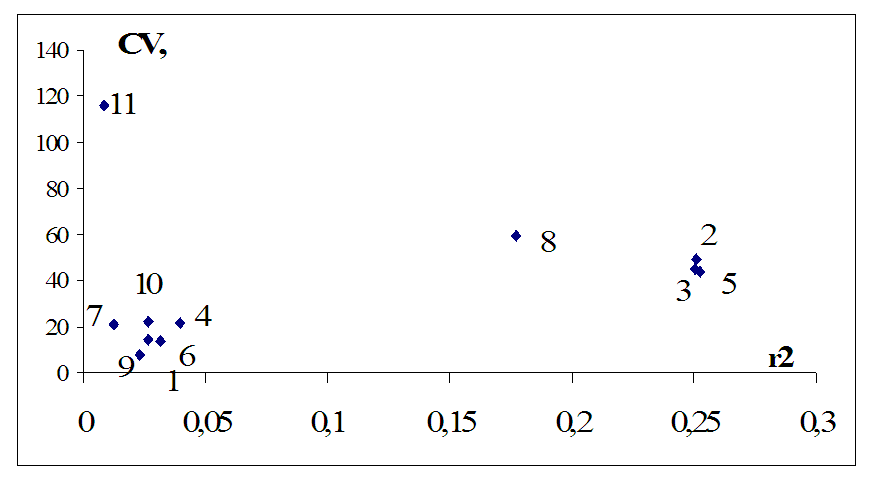-
Paper Information
- Paper Submission
-
Journal Information
- About This Journal
- Editorial Board
- Current Issue
- Archive
- Author Guidelines
- Contact Us
International Journal of Virology and Molecular Biology
p-ISSN: 2163-2219 e-ISSN: 2163-2227
2022; 11(2): 17-20
doi:10.5923/j.ijvmb.20221102.01

Methods of Selection of Raw Materials for Breeding Winter Wheat in Saline Soils
Utkirjon T. Jumanov1, Tojidin X. Kuliyev2, Musulmon I. Madraximov1
1Researcher, Gulistan State University, Gulistan, Uzbekistan
2Candidate of Agricultural Sciences, Associate Professor, Gulistan State University, Gulistan, Uzbekistan
Copyright © 2022 Scientific & Academic Publishing. All Rights Reserved.
This work is licensed under the Creative Commons Attribution International License (CC BY).
http://creativecommons.org/licenses/by/4.0/

This article describes methods for determining the resistance of genotypes of winter soft wheat to salinization and their criteria. The study was conducted in the laboratory of Experimental biology of Gulistan State University. About 300 genotypes of winter soft wheat were obtained as the object of the study. When determining the degree of salinity of winter wheat genotypes in conditions of slightly saline soil, the arimetic mean (Х±) and standard deviation (S) were used. With the help of these indicators, they are recognized as resistant to salinization if the marking index is greater than Х ± 2S. The yield was 846 g/m2, the dry matter content was 3.0 kg/m2. In laboratory conditions, a 1.0% solution of sodium chloride salt shows an increase in fertility by 51.0%.
Keywords: Productivity, Dry substance, Genotype, Collection, Concentration of solution, Sodium chloride salts, Germination, Salinity resistant, Non-resistant, Medium resistant, Correlation, Variation, Determination, Indicator
Cite this paper: Utkirjon T. Jumanov, Tojidin X. Kuliyev, Musulmon I. Madraximov, Methods of Selection of Raw Materials for Breeding Winter Wheat in Saline Soils, International Journal of Virology and Molecular Biology, Vol. 11 No. 2, 2022, pp. 17-20. doi: 10.5923/j.ijvmb.20221102.01.
1. Introduction
- Winter wheat is one of the main grain crops that meet the demand of the population for flour and flour products. In the "Strategy for the development of agriculture of the Republic of Uzbekistan for 2020-2030 ", the most important strategic objectives are to achieve an average yield of grain crops of 70 kg/ha by 2025. To do this, first of all, it will be necessary to choose scientifically sound, reliable primary sources for conducting breeding work. The initial resources are selected in the territory where the selection is carried out, which makes it possible to choose the genotypes suitable for this territory.Currently, the main methods for determining plant resistance to salinization are yields [1]. Productivity is a product of the environment and genotype, despite the fact that it is a highly variable, complex indicator. The productivity of the genotype in the salty fly indicates its resistance to salinization. One of the quick methods is to determine the resistance of genotypes to salinization using sodium chloride salt in laboratory conditions [2]. About 300 collection samples of winter wheat were analyzed using these methods. In this study, the resistance of winter wheat genotypes to salinization in a salty environment was studied for the first time. When selecting genotypes resistant to salinization, the criteria of the above-mentioned methods were calculated.The main purpose of the study was the selection of initial sources for the selection of winter wheat on saline soils.
2. The Main Results and Findings
- 286 genotypes of winter soft wheat Triticum aestivum L were taken as the object of the research, which were studied in 2019-2021 at the field experimental site of Gulistan State University. The following methods were used to determine the salinity resistance of plants in laboratory conditions [3,4]. The primary data were analyzed in the statistical program SPSS-17 [5]. Using this program, the correlation coefficients (r), determination (r2) and variation (Sv,%) between the studied features were calculated. The coefficient of determination of each feature (R2ch) and its average value (R2m) were calculated using the formulas [6].The results of statistical calculation of the characteristics of winter wheat genotypes and their quantitative indicators are shown in Table 1 below. From the above data, it follows that in conditions of slightly salted soil, the genotypes of winter wheat had an average height of 92.6 cm. According to this indicator, it can be seen that there is a difference between the genotypes in the minimum (60.0 cm) and maximum (130.0 cm) indicators. It is quite natural that such a condition is noted. Because each collection sample shows that the winter soft wheat variety has low, medium and low growth genotypes among the collection samples that have been studied by repeating characteristics. The number of spikes averaged 263, the minimum - 31, the maximum - 570. From these data it can be seen that this indicator is highly variable. In this case, the character will depend not only on the genotype, but also on the external factor. Variability was noted in all the studied signs.
 | Table 1. Signs of winter wheat genotypes and their quantitative indicators |
 | Figure 2. Degree and structure of correlations between quantitative characteristics of durum varieties and wheat samples ( R=0.3-0.5 R=0.3-0.5  r=0.5-0.7; r=0.5-0.7;  R=>0.7; R=>0.7;  r=-0.3-0.5.) r=-0.3-0.5.) |
 | Table 2. Criteria of methods for determining the salinity resistance of plants |
3. Conclusions
- 1. It is noted that in conditions of slightly salinized soil, the yield of winter wheat genotypes should be 846 g/sq.m with a dry matter content of 3.0 kg/ sq.m with a mass of one spike of more than 2.5 grams;2. When determining the genotypes of resistance to salinization in the laboratory, it is recommended to use a 1.0% sodium chloride solution. At the same time, it is noted that the germination rate should be higher than 51%.
 Abstract
Abstract Reference
Reference Full-Text PDF
Full-Text PDF Full-text HTML
Full-text HTML